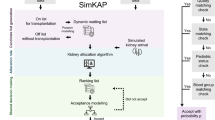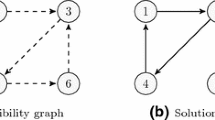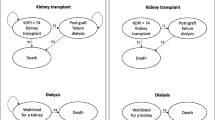Abstract
We created a dynamic stochastic model to evaluate the performance of a kidney transplantation system. Our model is applicable in the context of a small country where the legislation requires that a kidney from a deceased donor should be used whenever available. Using a systematic design of simulation experiments, we performed a complex simulation study based on real medical data to explore the impact of factors representing different rates of deceased kidneys harvesting, the proportion of patients with a willing living donor and different allocation policies. On the basis of careful statistical analysis carried out by two different statistical methodologies, ANOVA and bootstrap, we draw some important conclusions about the effects of these factors and recommendations for the medical community. The results of the study clearly demonstrate that in addition to increasing the numbers of kidney donors, deceased as well as living, the introduction of a kidney exchange program leads to further expansion of the numbers of donations and to shortening of waiting time for transplantation. Moreover, we observed that the largest and most counter-intuitive effect on waiting time and transplantation probability was obtained by replacing the currently implemented first-come-first-transplanted allocation policy to a policy that prioritizes the most vulnerable group of patients. This change has led to shortening the waiting time of these patients by enormous 28 months on average while leaving the waiting time of other patients practically the same.



Similar content being viewed by others
Notes
The main effect of a factor represents the average change in a response variable due to moving the factor from its “lower” to “higher” level while holding all other factors fixed (Law 2014).
References
Abellán J, Armero C, Conesa D, Pérez-Panadés J, Martinez-Beneito M, Zurriaga O, Garcia-Blasco MJ, Vanaclocha H (2006) Analysis of the renal transplant waiting list in the país Valenciá (Spain). Stat Med 25:345–358
Albers C, Lakens D (2018) When power analyses based on pilot data are biased: Inaccurate effect size estimators and follow-up bias. J Exp Social Psychol 74:187–195
Ashlagi I, Bingaman A, Burq M, Manshadi V, Gamarnik D, Murphey C, Roth AE, Melcher ML, Rees MA (2018) Effect of match-run frequencies on the number of transplants and waiting times in kidney exchange. Am J Transpl 18:1177–1186
Biró P, Haase-Kromwijk B, Anderson T et al (2019) Building kidney exchange programmes in Europe - an overview of exchange practice and activities. Transplantation 103:1514
Bunnapradist S, Danovitch GM (2007) Evaluation of adult kidney transplant candidates. Am J Kidney Dis 50:890–898
Chernick MR, LaBudde RA (2014) An introduction to bootstrap methods with applications to R. Wiley, Hoboken
Cohen J (1988) Statistical power analysis for the behavioral sciences, 2nd edn. Routledge, Hillsdale
Efron B, Tibshirani RJ (1993) An introduction to the bootstrap. Chapman and Hall/CRC, New York
Ferrari P, Fidler S, Woodroffe C, Tassone G, D’Orsogna L (2012) Comparison of time on the deceased donor kidney waitlist versus time on the kidney paired donation registry in the Australian program. Transpl Int 25:1026–1031
Fox J (2020) RcmdrMisc: R Commander Miscellaneous Functions. https://CRAN.R-project.org/package=RcmdrMisc. R package version 2.7-0
Halloran PF (2004) Immunosuppressive drugs for kidney transplantation. New Engl J Med 351(26):2715–2729
Heaf J (2017) Current trends in European renal epidemiology. Clin Kidney J 10:149–153
Hunter JD (2007) Matplotlib: a 2d graphics environment. Comput Sci Eng 9(3):90–95
IBM Corp. IBM SPSS Statistics for Windows, version 23.0. Armonk, NY: IBM Corp., (2015)
Jones E, Oliphant T, Peterson P, et al. (2019) SciPy: Open source scientific tools for Python. http://www.scipy.org/
Kim JH (2014) Features and ethical considerations associated with living kidney and liver transplantations in South Korea. Transpl Proc 46:3647–3652
Lakens D (2013) Calculating and reporting effect sizes to facilitate cumulative science: a practical primer for t-tests and ANOVAs. Front Psychol 4:863
Law A (2014) Simulation modeling and analysis, 5th edn. McGraw-Hill Education, NY
Lorscheid I, Heine B-O, Meyer M (2012) Opening the ‘black box’ of simulations: increased transparency and effective communication through the systematic design of experiments. Comput Math Organ Theory 18(1):22–62
Lüdecke D (2020) sjstats: Statistical Functions for Regression Models (Version 0.17.8). https://CRAN.R-project.org/package=sjstats
Maxwell SE, Delaney HD, Kelley K (2017) Designing experiments and analyzing data: a model comparison perspective, 2nd edn. Routledge, London
McKinney W et al (2010) Data Structures for Statistical Computing in Python. In Proceedings of the 9th Python in Science Conference, volume 445, pages 51–56. Austin, TX,
National Blood Service in Slovak Republic. (Národná transfúzna služba), (2019). Accessed: 15 June 2019, http://www.nto.sk/
National Health Information Center. (Národné centrum zdravotníckych informácií Slovenskej republiky), Health Statistics Yearbooks, (2019). Accessed: 15 June 2019, http://www.nczisk.sk
National Transplant Organization. (Národná transplantačná organizácia Slovenskej republiky), (2019). Accessed: 15 June 2019, http://www.nto.sk/
Norman G (2010) Likert scales, levels of measurement and the ‘laws’ of statistics. Adv in Health Sci Educ 15(5):625–632
Oliphant TE (2007) Python for scientific computing. Comput Sci Eng 9(3):10–20
Patel R, Terasaki PI (1969) Significance of the positive crossmatch test in kidney transplantation. New England J Med 280:739–835
Perlman Y, Elalouf A, Yechiali U (2018) Dynamic allocation of stochastically-arriving flexible resources to random streams of objects with application to kidney cross-transplantation. Eur J Op Res 265:169–177
R Core Team. R: A language and environment for statistical computing, (2019). http://www.r-project.org/
Rapaport F (1986) The case for a living emotionally related international kidney donor exchange registry. Transpl Proc 18(3):5–9
Santos N, Tubertini P, Viana A, Pedroso J (2017) Kidney exchange simulation and optimization. J Op Res Soc 68:1521–1532
Segev DL, Gentry SE, Melancon JK, Montgomery RA (2005a) Characterization of waiting times in a simulation of kidney-paired donation. Am J Transpl 5:2248–2455
Segev DL, Gentry SE, Warren DS, Reeb B, Montgomery RA (2005b) Kidney paired donation and optimizing the use of live donor organs. JAMA 293:1883–1890
Stanford DA, Lee JM, Chandok N, McAlister VC (2014) A queueing model to address wait time inconsistency in solid-organ transplantation. Op Res Health Care 3:40–45
Terasaki PI, Cecka JM, Gjertson DW, Takemoto S (1995) High survival rates of kidney transplants from spousal and living unrelated donors. New England J Med 333:333–336
Ushey K, Allaire J, Tang Y (2019)reticulate: Interface to ’Python’. https://CRAN.R-project.org/package=reticulate. R package version 1.14
van der Walt S, Colbert SC, Varoquaux G (2011) The NumPy array: a structure for efficient numerical computation. Comput Sci Eng 13(2):22–30
Wickham H, François R, Henry L, Müller K (2019) dplyr: A Grammar of Data Manipulation. https://CRAN.R-project.org/package=dplyr. R package version 0.8.3
Zenios SA (1999) Modeling the transplant waiting list: a queueing model with reneging. Queueing Syst 31:239–251
Zenios SA (2002) Optimal control of a paired-kidney exchange program. Manag Sci 48:328–342
Zenios SA, Wein LM, Chertow GM (1999) Evidence-based organ allocation. Am J Med 107:52–61
Acknowledgements
The authors would like to thank Daniel Kuba and Magdaléna Krátka, National Transplant Organization, for providing the details of the composition of the Slovak waiting list. Special thanks go to Jozef Hanč, Institute of Physics, P.J. Šafárik University, for his essential help in simulation data preprocessing and cross-validation for the subsequent statistical analysis and efficient bootstrap computations, using Scientific Python.
Author information
Authors and Affiliations
Corresponding author
Ethics declarations
Conflict of interest
The authors declare that they have no conflict of interest.
Additional information
Publisher's Note
Springer Nature remains neutral with regard to jurisdictional claims in published maps and institutional affiliations.
The work has been supported by VEGA grant 1/0311/18, APVV grant APVV-17-0568 and COST action CA15210 ENCKEP.
Appendix
Appendix
Here we present supplementary tables of results collected in our simulation study. Tables 4 and 5 are graphically visualized in plots (Figs. 2 and 3). Each cell in Tables 4 and 5 for any particular group of patients represents the numerical summary by the mean and SD for one of 32 design-point simulation experiments.
Rights and permissions
About this article
Cite this article
Cechlárová, K., Hančová, M., Plačková, D. et al. Stochastic modelling and simulation of a kidney transplant waiting list. Cent Eur J Oper Res 29, 909–931 (2021). https://doi.org/10.1007/s10100-021-00742-9
Accepted:
Published:
Issue Date:
DOI: https://doi.org/10.1007/s10100-021-00742-9




